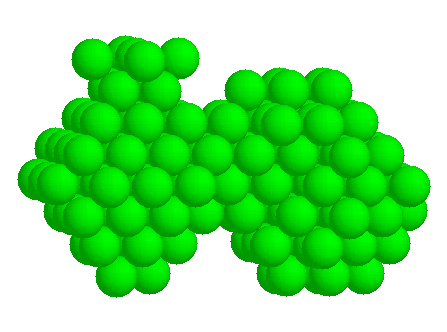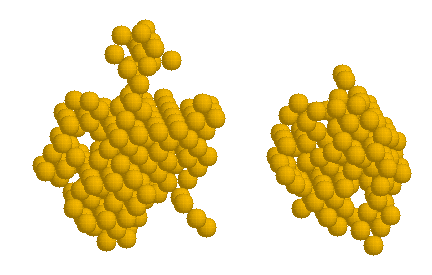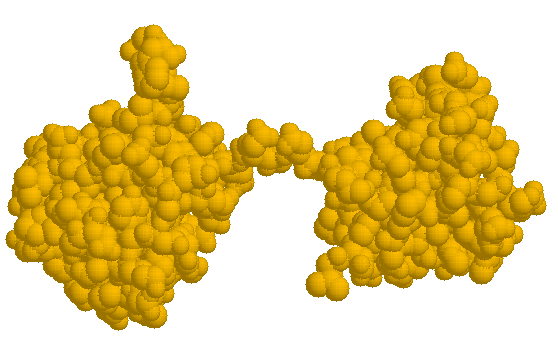DALAI-GA Tutorial
To illustrate the basic procedure to run the program her you can find several examples. In this first example the protein Beta b2-crystallin (2bb2 pdb entry) is modelled from SAXS. The data to be downloaded is calculated from 2bb2.pdb using the Debye formula, and from this theoretical SAXS profile the size & shape of this protein will be reconstructed.
Please, download now the following files:
- The parameter file: dalai_ga.ini
- The data file: 2bb2.int
- The initial search space (optional). There are to options 1) Direct generation of an ellipsoids from parameter file 2) Introduce your own conformational search space (e.g. L102.pdb). For simplicity, in this example DALAI-GA will generate a hexagonal packet of beads.
That's all what is needed to start. First at all have a look on the parameter file, it looks like that:
FILEINPUT 2bb2.int (SAXS data generated from the 2bb2 pdb entry) FILEMODEL none (No input initial search space) ELLSIZE 150 100 100 (Dimensions of the initial ellipsoid search space) RADIUS 7.0 (The beads will be of 6 A radius) DELTA_R 1.0 (Reduciton of R when new search space will be generated) END_R 3.0 (maximal resolution R allowed) MASS+/- 40 10 (Rejection size range in the initial population the models) RG+/- 30 5 (Allowed Rg range in the initial population ) NL/NC 10 100 200 500 (The program will wait 10 generations until starts waiting for convergece for all steps except the last one, then if after 100 generations without change of the best solution will cosider convergence reached and will proceed to next resolution step, for the last resolution step the the wait will be 200 generations and the convergence considered to be reached after 500 generations without change) DISPLAY 1 (Some info will show up in your screen while the soft is running)
========================================================
== ==
== DALAI_GA2 v3 Update 5/5/06 ==
== ==
== -------------------------- ==
== ==
== http:\\sbg.cib.csic.es\Software\Dalai_GA ==
== ==
========================================================
== INITIAL CONFIGURATIONAL SPACE:
409 spheres (ELLIPSOID 10x8x8) of radius 7.000000
Box 140.000000 X 96.994845 X 91.447617
volumen 587632.811459
-------------------------------------
-->Saved PDB init_confR7.0.pdb
PAIR-PAIR TYPES 88
RG 46.10 MassNorm 2064265
== SAXS DATA
Opened 2bb2.int ...... 64 point read
Srange 0.000000 - 0.060001 inter 0.000938
Internal particle constant 0.000000
WARNING!!!
Nominal SAXS resolution limit at R=4.166568
For radius 7.000000 Smax=0.035714
New Srange with 38 points
->Smin-Smax 0.000000 - 0.035239 inter 0.000927
== Generating initial random generation
DISCART RG 802 FIT 0
AVE RG 27.75 FIT 1.64
DISCART RG 7209 FIT 0
AVE RG 24.32 FIT 3.38
-------------------------------------------------------------
-------------------------------------------------------------
Overall time... 0 | Time R=7.0 0 | Converge time 100
Pos Fv N Rg OGA Rf RMS
1 13.9963 11 24.0811 0 7.6317e-02 1.8007e-02
2 9.6080 12 21.2897 0 1.5829e-01 3.8345e-02
3 9.3178 11 22.6603 0 1.5382e-01 3.6936e-02
4 8.8105 11 23.2251 0 1.3734e-01 3.2713e-02
5 8.2619 11 23.9800 0 1.5966e-01 3.8039e-02
6 8.1279 11 21.7111 0 1.7792e-01 4.2710e-02
7 7.4909 12 24.0514 0 1.3590e-01 3.2245e-02
8 7.3235 12 22.7126 0 1.6541e-01 3.9684e-02
9 7.2746 12 21.9817 0 1.8130e-01 4.3646e-02
10 7.2634 11 23.3642 0 1.7253e-01 4.0984e-02
Best configuration:
000000000000000000000000000000000000000000000000000
000000000000000000000000000000000000000000000000000
000000000000000000000000000000000000000000000000000
000000000000000000000000000000010000000001000000000
100000000010000000110000000000000000000000000000000
110000000000100000000000000001000000001000000000000
000000000000000000000000000000000000000000000000000
000000000000000000000000000000000000000000000000000
0
-->Saved PDB best_0.pdb
=== New Max FIT 15.6414 N 10 ===
-->Saved PDB best.pdb
->Saved SAXS best.dat
=== New Max FIT 19.5908 N 11 ===
-->Saved PDB best.pdb
->Saved SAXS best.dat
Each 10 generations the results are printed. The program will finish modelling at a given resolution when it has reached convergence. The fitting results are(best****.dat files) and the structures ofthe best models (best****.pdb files). The best configurations resulting can be displayed using rasmol:
>rasmol best.pdb >spacefill 160

and you can see the corresponding fits using your favorite plotting program, for example using gnuplot:
 >gnuplot
>gnuplot
gnuplot> set logscale y
gnuplot> set xlabel "S(A)"
gnuplot> set ylabel "I(S)"
gnuplot> plot "best.dat" u 1:2 w l, "best.dat" u 1:3 w l
Once the convergence was achived, the program automatically generates a new configurational space with smaller bead radius from the best result previously obtained.
== MASK PROCEDURE
146 hexagonal beads from box 479 of best config with 23
PAIR-PAIR TYPES 69
RG 28.08 MassNorm 274156
-->Saved PDB init_confR5.0.pdb
the configurational space is saved

the SAXS range take is modified according to the bead size used and a new initial population is generated
WARNING!!!
Nominal SAXS resolution limit at R=4.199422
For radius 5.000000 Smax=0.050000
New Srange with 214 points
->Smin-Smax 0.000100 - 0.049939 inter 0.000233
init max/min 62/17 target natom 0.0
init RG/RG_DELTA 24.70/4.94
mask conf Natom 40 RG 25.50 FIT 6.634239
DISCART RG 4980 FIT 2001
AVE RG 21.19 FIT 4.31
This refinment is repeated until desired resolution (parameter END_R in dalai_ga.ini), or automatically when the search space gets larger than 2,000 beads. At the end, one should have a complete set of models/fits (files *.pdb/*.dat), including the final results best.pdb and the corresponding fits best.pdb. The model with 3A radius beads looks like this:

That is, the structure obtained is convergent with the original crystallographic structure(2bb2 pdb entry), at a lower resolution

As a second example, we use the simulated SAXS profile produced by program DALAI using all 1914 atoms in the 1cfb.pdb file. We limit the range to be fitted to S=0.06A -1 , corresponding to real space resolution of 1/2S= 8.3A . Figure 7 shows a configurational space of 254 spheres of radius 6A .The spheres are hexagonally packed to provide the best mass sampling and are all within an ellipsoid of revolution of major/minor axes of 100/70A . This space is large enough to contain the crystal structure of two adjacent fibronectin type III repeats from the Drosophila neural cell adhesion molecule neuroglian (Huber et al. 1994, 1cfb entry in Brookhaven database).
 |
 |
 |
Figure 7. a) The configurational space of 254 spheres of radius 6A . b) and c) Connoly surface representation of the configuration space with ribbon representation of target structure embedded in it at two orthogonal projections.
Figure 8 shows the SAXS fit (fit and target profile can hardly be distinguished) and the average fitness of the parent population with the values for the best fits at a given iteration superimposed as spikes. Successively better fits improve the "genetic stock" until little further improvement can be achieved. Despite the enormous size of the configuration space (2254-1) the pertinent shape features of the structure at that resolution have been quickly identified. Only 29 spheres out of the 254 are retained. It is also clear that the size of the spheres is too large to accommodate fine details in the periphery of the molecule. This is reflected in ripples in the residual curve in Figure 8.
 |
 |
Figure 8. Top: Best fitted profile and residual (dashed line x10) after 330 iterations. The residual (dotted line) is scaled x10. Bottom: Average population fitness as a function of iteration number. The spikes superimposed on the smooth graph give the fit value of the best fit attained at a given iteration number.



Figure 9.Three projections of the fitted structure with the crystal structure shown in ribbon representation and the best fit of 6A spheres as a Conolly surface produced by program Insight II.
Increase in the quality of fit can now only be achieved by increasing the resolution of the configuration space (smaller spheres in a finer grid). Alternatively, as the low resolution shape of the structure is now known, the best fitted structure can now be used as a "mask", augmented by a margin around it and imposed on a finer resolution configuration space to define a subset of the spheres that would be contained in the original ellipsoid. This reduces the memory and processing time requirements significantly without loss in information to be extracted (Figure 10).






Figure 10 Top: Three orthogonal projections of finer resolution configuration space of 536 spheres of radius R=3A produced by adding a surface layer of 12A on the best fit from the previous run. Bottom: The best fitted structure (F=143) obtained by rerunning the algorithm.
If you feel already comfortable , it is time to try to model real datasets. Two test examples are:
- A) Troponin with 2 high affinity sites Calcium sites liganded:
- Data cortesy of Prof. T. Fujisawa (Fujisawa et al., J. Biochem Tokio 105:377-383, 1989. Fujisawa et al., J. Biochem. Tokio 107:343-351. 1990).
- B) The Beta4 fragment of alfa-beta 4 Integrin:
- Protein kindly provided by Dr. J.M. De Pereda (de Pereda et al., EMBO J. 18:4087-4095, 1999): Now you may try with your own data and search spaces, best luck and let us know your results!.